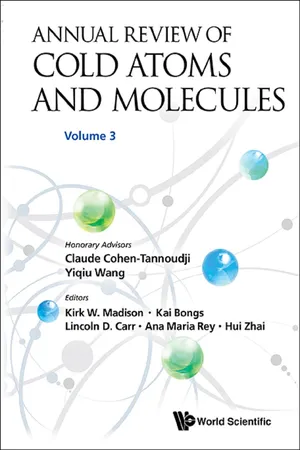![]()
CHAPTER 1
STRONGLY INTERACTING TWO-DIMENSIONAL FERMI GASES
Jesper Levinsen* and Meera M. Parish†
*
Aarhus Institute of Advanced Studies, Aarhus University,
DK-8000 Aarhus C, Denmark
[email protected]†London Centre for Nanotechnology, University College London,
Gordon Street, London, WC1H 0AH, United Kingdom
We review the current understanding of the uniform two-dimensional (2D) Fermi gas with short-range interactions. We first outline the basics of two-body scattering in 2D, including a discussion of how such a 2D system may be realized in practice using an anisotropic confining potential. We then discuss the thermodynamic and dynamical properties of 2D Fermi gases, which cold-atom experiments have only just begun to explore. Of particular interest are the different pairing regimes as the interparticle attraction is varied; the superfluid transition and associated finite-temperature phenomenology; few-body properties and their impact on the many-body system; the “Fermi polaron” problem; and the symmetries underlying the collective modes. Where possible, we include the contributions from 2D experiment. An underlying theme throughout is the effect of the quasi-2D geometry, which we view as an added richness to the problem rather than an unwanted complication.
1.Introduction
Following the successful realisation of strongly interacting atomic Fermi gases in three dimensions (3D), attention has now turned to Fermi systems that have, in principle, even stronger correlations, such as low-dimensional gases and fermions with long-range dipolar interactions. Model two-dimensional (2D) systems are of particular interest, since they may provide insight into technologically important, but complex, solid-state systems such as the high-temperature superconductors,1 semiconductor interfaces,2 and layered organic superconductors.3 Moreover, 2D gases pose fundamental questions in their own right, being in the so-called marginal dimension where particle scattering can be strongly energy dependent, and quantum fluctuations are large enough to destroy long-range order at any finite temperature.4,5
In this review, we focus on the uniform 2D Fermi gas with short-range interactions, since this has already been successfully realised experimentally.6–17 Here, two species of alkali atom are confined to one or more layers using a 1D optical lattice or a highly anisotropic trap. The interspecies interactions may then be tuned using a Feshbach resonance, making cold atomic gases ideal for studying the behavior of fermions in low dimensions. While the cold-atom system is clearly much simpler than solid-state systems, where the long-range Coulomb interactions are difficult to treat and there are often complex crystal structures, the usual toy models for such systems neglect the long-range interactions and consider simple contact interactions like the ones described here in this review. In particular, the attractive 2D Fermi gas provides a basic model for understanding pairing and superconductivity in 2D.18–20 Here, by varying the attraction, one can investigate the crossover from BCS-type pairing to the Bose regime of tightly bound dimers. In the interests of space, we do not consider further extensions such as dipolar interactions, spin-orbit coupling, or any lattice within the plane. Indeed, we note that a degenerate 2D dipolar Fermi gas has yet to be achieved experimentally, while the pursuit of the 2D Hubbard model is still ongoing.
The investigation of strongly interacting 2D Fermi gases, as described in the following, may be encompassed within several broad themes. Firstly, there is the interplay between Bose and Fermi behavior as the attraction is varied. This is particularly apparent at finite temperature where the normal state evolves from a Fermi to a Bose liquid, and one has the possibility of the so-called pseudogap regime. Potentially even richer behavior may be derived from Fermi-Fermi mixtures with unequal masses and/or imbalanced “spin” populations. While attempts to confine mass-imbalanced mixtures to 2D are still underway, experiments with equal masses have already realized the regime of extreme spin imbalance,14 corresponding to a single impurity problem. Here, it has emerged that even the strongly interacting impurity can be well described by wave functions that only contain two- and three-body correlations. A related theme is the importance of few-body phenomena in the many-body system. As well as being relevant to high temperatures, where the thermodynamic properties are well described by the behavior of few-body clusters (i.e., the virial expansion), few-body properties are also required to properly describe the Bose regime of the pairing crossover. Turning to themes unique to the 2D system, we have the existence of classical scale invariance and its impact on the collective modes in a harmonic trap. Finally, there is the question of how 2D experiments really are, since in practice there is always a finite transverse “size” of the quasi-2D geometry. To be in the 2D limit, we require the length scales associated with the quasi-2D gas (i.e., the dimer size, the thermal wavelength, and th...
